
 |
JPL's Wireless Communication Reference WebsiteChapter:
Analog and Digital Transmission
|
| Playlist |
IS-95 Cellular CDMA basics Data and TCP/IP over IS-95 Full U.C. Berkeley Talk More on CDMA and Wireless Computing |
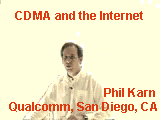
| M3U Files |
| Audio Clip | Duration | Description | Further Reading | ||
| .'.." |
Introduction of the speaker by Randy Katz, Professor and Department Chair. Introductory jokes.
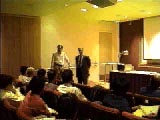 Dept. of EECS, Cory Hall, University of California at Berkeley. | ||||
| 0'33" |
CDMA is a generic term used for the IS-95 standard for cellular radio, using Code Division Multiple access.
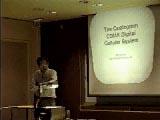
| ||||
| 0'49" | CDMA and spread spectrum came from military technology. | CDMA | |||
| 1'09" | All radio systems are FDMA fundamentally. IS-95 uses CDMA on top of FDMA.
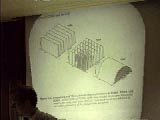
| Multiple Access, FDMA, IS-95 | |||
| 1'47" | Qualcomm claims spectrum efficiency to be 10-15 times better than TDMA. Low RF transmit power. Voice quality. Simple frequency managemant. (We apologize for some clicks in audio) | Spectrum Efficiency | |||
| 2'01" | Randy Katz: "What are operational experiences on spectrum efficiency". | ||||
| 1'23" | Direct sequence with long and short codes. | DS, IS-95, forward link | |||
| 2'37" | Acquistion process. Selection of codes. How to separate users. | ||||
| 1'23" | Rake receiver. Soft Handoff. | Rake, soft handoff | |||
| 0'25" | Processing power of rake. The search finger. | ||||
| 1'25" | Same short sequences in all cells. Fast search. Site diversity.
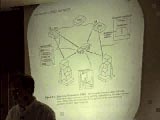
| ||||
| 0'53" | Soft handoff: creative use of multipath. | Multipath | |||
| 0'56" | Various forms of diversity in IS-95. | Diversity | |||
| 0'46" | Power control problem has been resolved. | Power control | |||
| 1'27" | Power consumption. RF transmit power. | Power consumption |
| Audio Clip | Duration | Description | Further Reading | ||
| 0'51" | Phil Karn's own work. How to send data over IS-95? Different worlds of telephone operators and internet. | ||||
Architecture: the system is built on IS-95 with voice protocols above it.
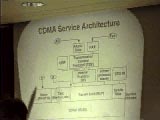
| |||||
| The data protocol design filosophy. Where to solve performance problems? What to solve at the radio link level, and what to leave for higher-layer protocols? The radio link protocols provide a performance that is "just good enough", without introducing too much overhead in the transmission blocks of bits (cells). | Wireless Computing, TCP/IP | ||||
| CDMA frames are small. One packet is 75 frames. Even with small frame error rates, the packet erasure rates would be too high without error control. On the other hand, bullet-proofing the link would make the system too inefficient. Effective throughput depends on erasure rates and on error and retransmission control overhead. | Eff. Throughput | ||||
| Wireless links, if well-designed, tend to give fairly good error rates most of the time, but with occasional fades. Radio links are not like noisy channels that give random bit errors. It more like a wireline link, but one that "isn't there" all the all the time. | Gilbert-Elliot Model | ||||
| Negative acknowledgement and retransmission protocol. | |||||
| Packet erasures remain. TCP will take care. | |||||
| Raw packet erasure rates and PER after the radio link protocol. Bursts of packet erasures. | |||||
| More details in TIA standards, such as IS-95 and IS-99. | |||||
| Question by Randy Katz: What are the operational experiences by Qualcomm's CDMA cellular network. | |||||
| Advantages of Direct Sequence over Frequency Hopping. "A Religeous Battle". | FH | ||||
| Spectrum Scarcity. Phil Karn and Randy Katz comment. | Spectrum Scarcity Randy Katz |


